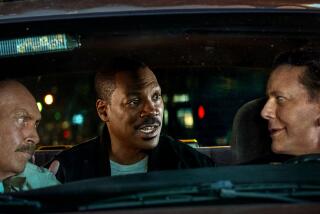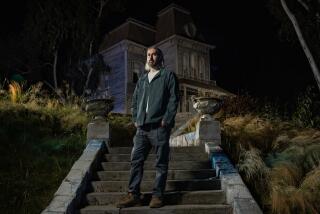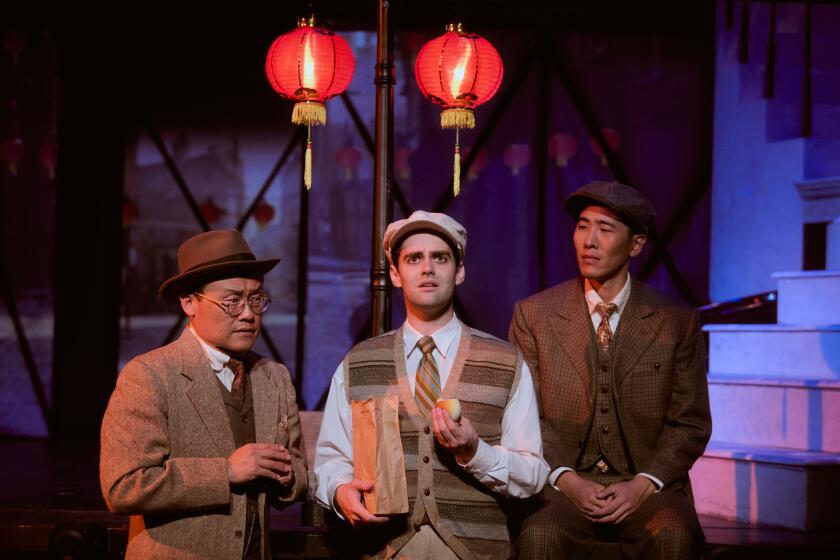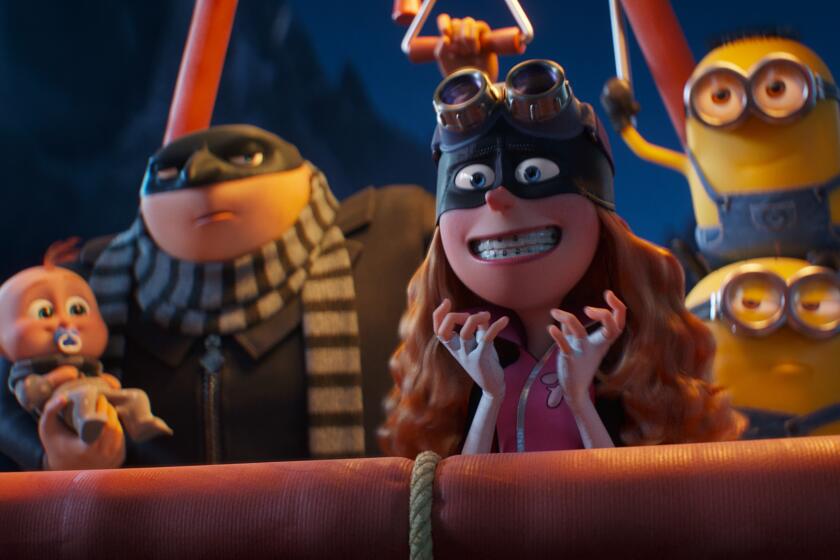Still a Dizzying Experience
Proof of the fallibility of film critics, should it be needed at this late date, is as close as the reviews that greeted Alfred Hitchcock’s “Vertigo” when it opened in 1958.
“Another Hitchcock-and-bull story,” sneered Time magazine. The New Yorker said the director “has never before indulged in such farfetched nonsense,” and this newspaper lamented that the film “bogs down in a maze of details.” Partisans conceded as well that this was minor Hitchcock at best.
Even seven years later, when iconoclastic British critic Michael Wood had the temerity to call “Vertigo” “one of the four or five most profound and beautiful films the cinema has yet given us,” he made sure to follow his statement with the acknowledgment that “this is a claim that may surprise, even amuse, the majority of my readers.”
That kind of disclaimer is no longer very much
in evidence, as “Vertigo” is conceded to be, in the words of Hitchcock biographer Donald Spoto, the director’s “richest, most obsessive, least compromising film.” By 1992, when the British Film Institute did its once-a-decade survey of the world’s film critics to compile an all-time 10-best list, “Vertigo,” which hadn’t been listed in 1962 or 1972, came in fourth place, bested only by Orson Welles’ “Citizen Kane,” Jean Renoir’s “Rules of the Game” and Yasujiro Ozu’s “Tokyo Story.”
What’s going on here? Why has a film dismissed by the keenest minds of 1958 become an icon of modern cinema? Were they crazy or are we? Or is it simply that “Vertigo” defines the concept of art that is ahead of its time, a motion picture whose virtues resonate much more strongly with contemporary viewers than they could have done nearly four decades past.
For nearly 20 years, from 1967 to 1984, that question was difficult to answer because “Vertigo,” for a variety of reasons, was taken out of theatrical distribution. It returned briefly in 1984, but the print quality was sketchy. Now, after two years of work and $1 million spent, a restored and revitalized print of “Vertigo” gets a Los Angeles play date starting Wednesday as part of a nationwide re-release.
Restoration partners Robert A. Harris and James C. Katz, whose credits in this area include “Lawrence of Arabia,” “Spartacus” and “My Fair Lady,” have done more than bring back the original’s vivid colors so beautifully that the print looks like it did the day it premiered.
To best take advantage of 1958’s VistaVision format, this “Vertigo” is for the first time going out in 70 millimeter. And Bernard Herrmann’s original monaural score has been remastered in brilliant DTS digital sound that leaves no doubt about why it’s considered one of the pinnacles of modern film music, unsettling and Wagnerian with hints of something evil this way coming.
As a result, “Vertigo” stands revealed as what it probably always was, an audacious, brilliantly twisted movie, infused with touches of genius and of madness. A disturbing meditation on the interconnected nature of love and obsession disguised as a penny dreadful shocker, it’s more impressive today than 40 years ago because of several interconnected factors.
For one thing, the 1960s New Wave, the rise of independent film and the proliferation of academic film studies have combined to give considerable cachet to the notion of subjective movie-making. And though it was made in the heart of the studio system, “Vertigo” is as intensely personal as any entry at Sundance, with some of the biggest stars of the day helping Hitchcock work through the nakedest version of his perennial fascinations with glacial blonds and the ghastly jokes of fate.
Hitchcock was able to get away with this because he worked within the context of a thriller plot. “Vertigo” started out as a novel called “D’entre les Morts” (Between the Dead) by the French team of Pierre Boileau and Thomas Narcejac, the same pair who had written the book on which Henri-Georges Clouzot’s “Diabolique” was based. In fact, though Hitchcock didn’t find out until his celebrated series of interviews with Francois Truffaut years later, the new novel had been specifically concocted to get Hitchcock’s attention.
‘Vertigo,” the film that resulted, focuses on John “Scottie” Ferguson (James Stewart), a San Francisco-based police detective forced into early retirement by the sudden onset of acrophobia, a fear of heights that brings on intense dizziness or vertigo.
Reduced to spending his spare time with Midge, a sensible ex-girlfriend (played by Barbara Bel Geddes, later known as Miss Ellie on “Dallas”), Scottie is intrigued to get a proposition from an old college buddy named Gavin Elster (Tom Helmore), now a wealthy San Francisco businessman.
Elster is concerned about his wife, Madeline. Though he knows it sounds farfetched, Elster feels something or someone has taken possession of Madeline, possibly from beyond the grave, and because he fears for his wife’s safety and sanity, he wants her followed by someone he knows and trusts.
Scottie, who prides himself on his hardheaded practicality, is dubious at first, but his first glimpse of the blond and ethereal Madeline, breathtaking in a black evening gown with a teal wrap, changes his mind. One look also tells us what Scottie himself is not ready to admit: He’s intoxicated enough to follow this woman anywhere.
Where anywhere turns out to be is one of the many shocks this famously unpredictable plot has in store. Yet, difficult though its twists are to anticipate, “Vertigo” is most talked about for the way, in vintage Hitchcock fashion, it gets its strongest effects not out of surprise but from the more satisfying notion of suspense. The idea is to let the audience in on things the characters don’t know and exploit our anticipation of how they’ll react when they find out.
Madeline is played, in one of her strongest and most persuasive performances, by Kim Novak. Projecting a powerful, otherworldly sensuality, she underlines Truffaut’s comment to Hitchcock that “very few American actresses are quite as carnal on screen.” It’s hard to imagine “Vertigo” without her, yet that’s what the director was determined to do.
Hitchcock had initially preferred Vera Miles, who had co-starred in his 1957 “The Wrong Man” with Henry Fonda. But Miles became pregnant, and the director was not amused. “It was her third child,” he explained to biographer Spoto, “and I told her that one child was expected, two was sufficient, but that three was really obscene. She didn’t care for this sort of comment.”
Although he was too peeved at Miles to use her, even though shooting ended up starting so late that she became available again, Hitchcock was far from keen on Novak, a top box-office draw who had come to the project as part of a deal engineered by Lew Wasserman that had her and co-star Stewart then segue to “Bell, Book and Candle.” For one thing, she was independent-minded and had her own ideas about things like wardrobe, a stance the director had little patience with. “My dear Miss Novak,” he is famously said to have replied, “you can wear anything you want, anything--provided it is what the script calls for.”
Hitchcock, who could be something of a sadist on the set, is said to have taken his revenge by insisting on multiple retakes (one estimate is 24) of a scene that called for Novak being dunked in a studio tank. Still, the actress apparently didn’t hold a grudge, telling a reporter years later: “Hitchcock was dictatorial, but at heart he was a sweet, charming man. He didn’t know how to relate to actors as people. He could put you into his plots, but it was a chess game. You were just a piece.”
Equally problematic for a long time was how to turn the novel’s plot into an acceptable script. Playwright Maxwell Anderson did a first draft with the unpromising title “Darkling I Listen.” Alec Coppel did a second version and ended up sharing screen credit with Samuel Taylor, who also wrote “Sabrina” and came up with the key element that made everyone happy.
Taylor, who never read the original novel, explained in a later interview that he had told Hitchcock that the problem with the Coppel script was “ ‘a matter of finding reality and humanity for these people. You haven’t got anybody in this story who is a human being; nobody at all. They’re all cutout cardboard figures.’ I told him immediately that I would have to invent a character who would bring Scottie into the world, establish for him an ordinary life, make it obvious that he’s an ordinary man. So I invented Midge.” Stewart, for one, was so delighted he charged into the director’s office and said, “Now we have a movie, now we can go ahead!”
Once Hitchcock began to work, another of the qualities that make him a figure of increasing interest came into play: the amount of craft he brought to the table, acquired by directing dozens of pictures over three decades and consequently rare today. Hitchcock was a master of every detail of the filmmaking process, meticulous enough to have Novak practice some of her movements to a metronome. His solution to simulating Scottie’s vertigo, done by having the camera simultaneously zoom in and track out, was the result, he told Truffaut, of 15 years of thinking about how best to show dizziness on screen.
So strong was Hitchcock’s control of the medium that, working with cinematographer Robert Burks, he was able to bend San Francisco to his will, creating a deliciously ghostly metropolis, nearly deserted and not of this world. He also shrewdly combined studio shots with location work, re-creating in carefully measured detail such San Francisco landmarks as Ernie’s restaurant and Ranshohoff’s department store on L.A. sound stages.
The mission at San Juan Bautista, 90 miles south of the city, is a key “Vertigo” location, but in real life it doesn’t have a critical bell tower. So Hitchcock constructed one in the studio and superimposed it on the shot. His pure skill as a director is crucial to making the story plausible and shows why screenwriter Taylor later said, “I don’t believe there’s anybody who in purely cinematic terms is Hitchcock’s equal.”
Finally, more than Hitchcock’s ability, what connects most impressively to today’s audiences is the strange darkness of “Vertigo’s” themes, its moments of obsessive eroticism, its tipping of the hat to sadism, masochism, fetishism, necrophilia and more garden-variety neuroses. The film’s continued ability to unsettle and disconcert without resorting to graphic visuals underlines how modern and timeless its themes and execution remain.
Interestingly enough for a film that became so celebrated, all of “Vertigo’s” creators had problems with the project. Not only had Hitchcock wanted Vera Miles, but he grumbled later that the film had done poorly at the box office because Stewart looked too old. Screenwriter Taylor said he would have preferred Ingrid Bergman for the female lead, and composer Herrmann said: “They never should have made it in San Francisco and not with Jimmy Stewart. I don’t think that he would be that wild about any woman. It should have been an actor like Charles Boyer. It should have been left in New Orleans, or in a hot, sultry climate.”
Yet despite all this nattering negativity, “Vertigo” continues to have the strongest possible effect on audiences. Because Alfred Hitchcock put so much of himself into the film, “Vertigo” plainly demands an equally strong and personal response. And having it back on big screens in pristine condition has to be the film event of the year.
*
* “Vertigo” opens Wednesday at the Avco General Cinema, 10840 Wilshire Blvd., Westwood. (310) 475-0711.
More to Read
Only good movies
Get the Indie Focus newsletter, Mark Olsen's weekly guide to the world of cinema.
You may occasionally receive promotional content from the Los Angeles Times.







